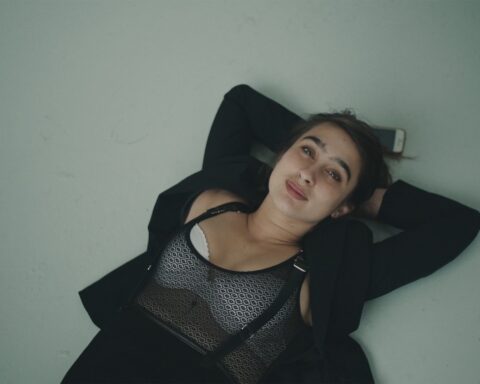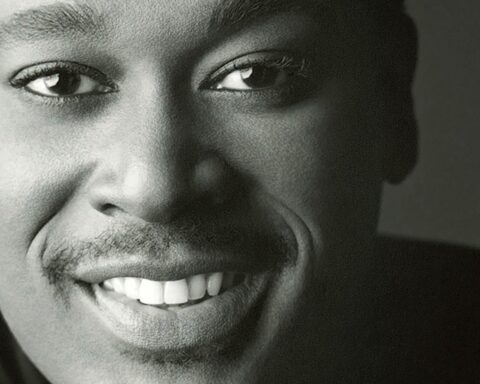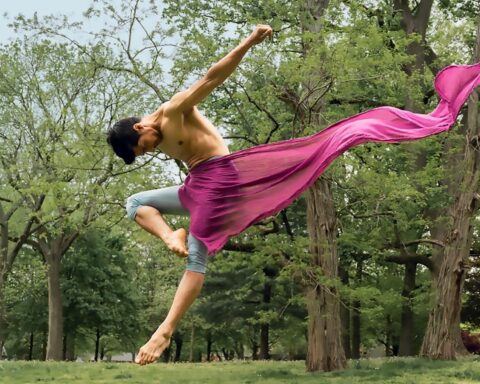Kusama: Infinity
(USA, 80 min.)
Dir. Heather Lenz, director
Starring: Yayoi Kusama
Toronto is experiencing a Kusama moment. The Art Gallery of Ontario’s (AGO) show Kusama: Infinity Mirrors has been sold out for months. Only rush tickets are available for the current retrospective on the 89-year-old Japanese artist Yayoi Kusama, which runs until May 27. If you’d like an opinion from a film critic who has seen the show, head into one of those rush lines. Kusama’s work is worth the wait.
Known as the “polka dot artist,” Kusama’s paintings, drawings, installations, performances and film go far beyond that simple description—though they have inspired striking fashion statements worn by some of the gallery’s attendees. Ever imaginative, Kusama’s work is challenging, gorgeous, and quite varied in its formal approaches. She doesn’t rely on gimmicks; in fact, she’s one of the finest artists of her generation.
Now another major Toronto cultural institution, TIFF, is getting into the act. Kusama – Infinity, a new documentary on the amazing artist is starting its run at Bell Lightbox. While the film’s screenings will clearly not match the popularity of the gallery exhibit, it will help any viewer of the AGO show to understand her mutable art and very difficult life. And it’s a well-made doc, worth seeing by filmgoers who don’t go to art shows.
This being a biopic that recounts the career of an octogenarian, it’s not surprising that first time feature director Heather Lenz structures the work conventionally. There are the inevitable talking heads—Kusama experts Frances Morris (Tate Contemporary), Alexandra Munroe (Guggenheim) and Lynn Zelevansky (Carnegie)—who guide us through her art and some of her personal history. Archival footage, especially from her heyday in New York’s crazy art scene in the Sixties, adds visual spice to the mix. Shots of Kusama now, an aging but clearly addled icon in Tokyo recalling her past, add a dollop mystery to the doc’s narrative: what brought her to the state she’s in?
Lenz views Kusama’s tale as one of a woman of great talent, whose career was blighted by sexism and racism. She makes a great case for it. In the early Sixties, as an artist fighting to get into the New York gallery scene, Kusama was endlessly inventive. She created a soft sculpture fabric piece in the shape of a couch many months before Oldenberg achieved fame by doing a variant on the same thing. Andy Warhol attended a Kusama show that concentrated on an installation called 100 Boats, replete with phallic sculptures and surrounded by photos of the piece.
A few months afterward, Warhol’s show featuring a pop art cow placed in a room full of photographs of the bovine became a huge success. Next, Kusama created the first of her mirrored rooms in which the infinity of the universe can be viewed through a myriad of flashing lights (don’t you dare call them dots!). A few months later, Lucas Samaras scored his biggest hit with a mirrored room that was far less visually imaginative.
At that point, Kusama actually threw herself out a window but survived. In the late Sixties, she attended—uninvited—the Venice Biennale. She sold beautiful mirrored balls called Narcissus for $2 a piece—until the administration forced her to stop her “commerce.” They had completely missed Kusama’s intention, which was to call into question the gallery system, not make a small profit. After returning to New York, she staged anti-Vietnam War nude protests, complete with rock music and body painting. Her “happenings” were dismissed as merely scandalous, with no substance.
Eventually, Yayoi Kusama returned to Japan, where she was treated dismissively. In the mid 1970s, she committed herself to a mental institution, where she continues to reside. For a while, she wrote novels but soon came back to making art. For decades, she was ignored but starting with a retrospective curated by Beate Gordon in New York in 1989, she began to attain status. A triumphant return as the sole Japanese artist at the Venice Biennale in 1993 prompted a complete reevaluation of her work. Now, at 89, she is the most successful (in financial terms) female artist in the world.
Yayoi Kusama continues to live in the same mental institution but she also allowed to leave every day, to create work in a large staffed studio two blocks from her home. She continues to make work—and they aren’t hackneyed remakes of older paintings. Lately, she’s been painting large canvases of forms that resemble cactuses and other forms typical of the American West. Yes, there are dots, but that’s only one element of the work. With those gorgeous paintings, it’s as if she’s returning to the first person who embraced her work, the great artist Georgia O’Keefe, who created her own work in New Mexico for decades.
Heather Lenz has made a loving respectful film about a subject well worth documenting. If you love art, this is a must-see.
Kusama – Infinity opens at the Lightbox on May 11th.
It is the closing night selection at Vancouver’s DOXA Documentary Festival on May 12.











